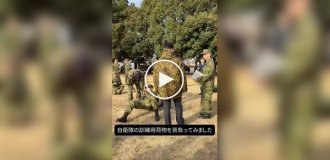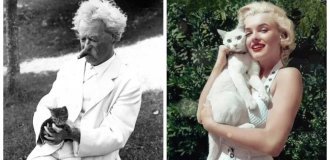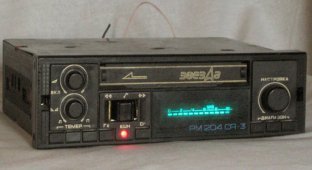The operation of the tape recorder is based on the principle of magnetic recording of audio frequency signals with high-frequency bias on a wire sound carrier with automatic erasure of the previous recording by a high-frequency field (about 25 kHz) created in the working gap of the erasing head.

Among the first - the wire tape recorder "PM-39" since 1939 was produced by the Leningrad plant named after. Kazitsky. Or rather, he did not produce it, but converted the C. Lorenz devices purchased in Germany into domestic radio tubes and put up signs with Russian inscriptions. While the Germans, already in 1935, demonstrated a tape recorder they had invented that recorded phonograms on magnetic tape, the USSR continued to develop sound recording equipment on other media. A lot of things were developed, but they were not suitable for industrial production. Therefore, for the needs of various departments (mainly the military), a batch of wire tape recorders was purchased in Germany and transferred to the Kazitsky plant. After the rework, the device received the name “PMrkt-39”, later simply “PM-39” (Wire tape recorder 1939).

The tape recorder was an exhibit at the Moscow Polytechnic Museum. It has no name and is marked with the date 1941. The tape recorder used a thin steel wire on a reel containing about 4...4.5 kilometers. The speed of drawing the wire through special, separate heads is variable and adjustable from 10 to 60 cm/sec. The operating frequency range of sound is 300...7000 Hz at maximum speed. The recording or playing time of one reel is up to 24 hours.

The special wire tape recorder "MIZ-10" was allegedly produced by the Rybinsk Instrument Making Plant since 1961. The tape recorder is intended for the needs of newly created strategic missile forces.



Since the beginning of 1961, the special wire transistor tape recorder “MH-61” was produced by the Vilnius plant “Vilma” and the Rybinsk instrument-making plant.
The tape recorder is intended for recording and reproducing speech from a receiver, lines and microphone in airfield conditions or combat units of the Air Force, as well as for reproducing recordings made on the MS-61 aircraft tape recorder.
The sound carrier is a special wire such as EI-708A or EI-708. The duration of continuous recording on a cassette is ~ 5.5 hours. The rewind time of the audio carrier is about 35 minutes.
The unevenness of the frequency response at a frequency of 1000 Hz is no worse than 4 dB, when the input signal changes from 10 to 70 V from the radio receiver input. The unevenness of the frequency response in the frequency range 300...3000 Hz when setting the tone controls in the middle position is no more than 10 dB.
Dynamic range of at least 30 dB. The coefficient of nonlinear distortion of the recording/playback path is about 10% at a frequency of 1000 Hz. The frequency of the erasing and bias current is 20 KHz. The output voltage on a 1GD-18 type loudspeaker is 1.5 V, on TA-56M phones 1.8 V, on the same, but high-impedance (3.2 kOhm) 20 V. The tone control limits are at least 5 dB. If the sound carrier breaks or ends during recording, voltage is supplied to start the backup tape recorder.
The tape recorder has an auto-start device that automatically turns off the tape recorder when the input signal ends and automatically turns on when a signal appears during recording. Power supply from AC mains frequency 50 Hz with voltage 110, 127, 220 V. Power consumption 75 W. The dimensions of the tape recorder are 326x241x236 mm. Weight 12 kg.






The special wire tape recorder "P-504N" (NU, NZ) was produced presumably since 1990. The tape recorder is designed for reproducing information from wire recording media taken from on-board (aircraft) tape recorders "P-503B" (BS, BZ) and MS-61(B), recording speech in continuous mode or auto-start mode from the line, receivers and microphone, as well as time code signals.
Tape recorders P-504NU, P-504NZ provide remote activation of recording modes and rollback playback. Tape recorder P-504NZ with low-impedance inputs and outputs. They are installed on special vehicles, mobile or stationary communication points, and on marine light speed boats. The tape recorder replaces the MH-61 tape recorders.
Duration of continuous recording is 9 hours. The unevenness of the frequency response in the range of 300...3400 Hz is no more than 10 dB. Power supply: AC 220 V, 50 Hz and 115 V, 400 Hz. Power consumption 75 VA. Speeds: speed 1 - 100 mm/s, speed 2 - 145...195 mm/s. Detonation coefficient 7%. Rewind time 40 min. It is possible for the media to move forward and backward during playback.



The wire portable tape recorder "Triton" was produced presumably since 1962. The tape recorder is intended for the special services of the KGB of the USSR.




The portable wire voice recorder "Mezon" was allegedly produced from 1960 to 1987 for the special services and the Ministry of Internal Affairs. Dimensions of the device are 158x75x26 mm. Weight without power is 500 g. The wire on the reel is enough for 1.5 hours of recording. Reel dimensions 35x12 mm. Rewind time 1 hour. Power supply - 7 V from a BOR battery, OR-2K (RTs-63) cells, DEAC batteries or 5 Saturn cells placed in an external container.

There is no erasing head; erasing is carried out by an external demagnetizing choke. The pasik transmits movement from the engine to a horizontal flywheel, which in turn rotates one of two rubber-coated faceplates, depending on the operating mode. The universal head moves up and down using a worm mechanism. There is an auto-stop that is triggered when the wire runs out on the feed reel. At the same time, a spring-loaded lever on the feed reel, held by coils of wire, is released and presses the auto-stop lever located under the feed reel. The latter opens the contacts of the motor circuit. The kit has the necessary set of accessories, such as additional coils, including those with wire, a power adapter, an adapter for recording from an external source, an adapter for contactless recording from a telephone line, a demagnetization choke, a BOR battery, cups of OR-2K elements (RTs- 63), earphone TM-2, tube with lubricant, wire threading device.




Aircraft tape recorder MS-61. Adopted into service in 1961.
Designed for recording speech from the outputs of the SPU (aircraft intercom) and automatic recording from the ship's commander's laryngophones. Speech is recorded on a wire with automatic erasure of previous information. Typically, an aircraft is equipped with two tape recorders. If the sound carrier breaks or runs out, the backup tape recorder is automatically switched on.
The MS-61 tape recorder is housed in a spherical armored sealed case. On the outside, for greater visibility at the crash site, the hull is painted orange. The recording is made on a magnetic steel wire. To play back the recording, an MH-61 ground tape recorder is used.
Installed on An-12, An-22, Il-76, Su-24, Su-25, Tu-16, Tu-95, Tu-134 aircraft, Ka-32, Mi-6 helicopters.
The duration of recording on a cassette is at least 5.5 hours.
Linear speed of sound carrier movement - 150-180 mm/s

Structurally, the armored casing consists of two double-walled hemispheres with heat-insulating material between the walls. The inner wall of each hemisphere of the casing is made in the form of a hollow “shirt”, the volume of which is 80% filled with distilled water. The internal volume of the casing is filled with foam plastic. The design of the armored casing provides protection for the wire sound carrier of the recording apparatus from mechanical shocks and high temperatures in case of accidents.

EI708A wire is a so-called precision (high accuracy of parameters) alloy. If translated into the language of materials scientists, this is 14NHM - 0.14% C; nickel, chromium, molybdenum - up to 1.5%
























